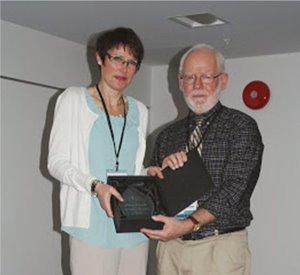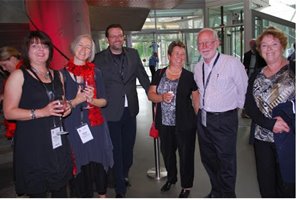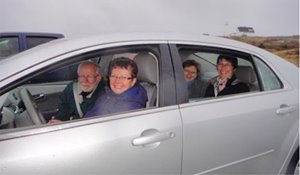Pat Letendre interviews our TM colleagues - past & present:
It's my pleasure, indeed an honour, to write a series of blogs for CSTM to celebrate the careers of transfusion professionals who came before and made a difference. Some names you may recognize, some you may not. But rest assured they all made a difference and we are the better for it.
Each blog begins with a brief background on the person's career, followed by musings on their career and my comments throughout. If you're looking for a rosy view of Canada's transfusion medicine field, this ain't it. Why? Although all participants enjoyed their careers and love the transfusion profession, they speak honestly about both the ups and downs. Perhaps their reflections will resonate with your experiences.
I will remember you: Kieran Biggins
This blog features Kieran Biggins, a medical laboratory technologist I met years ago when he was already in Lethbridge, Alberta and I was in Edmonton. We learned that we both worked in Winnipeg with Dr. John Bowman, me at the Canadian Red Cross Blood Transfusion Service in the 1960s and 70s and Kieran at the renowned Rh Laboratory in the 1980s.
BACKGROUND
Before you can appreciate how Kieran made a difference and understand his musing, you should know a few of his experiences. I encourage you to consider your career compared to his and how you may muse on transfusion medicine.
Kieran, a native of Scotland, began his 38-year career in Glasgow, Scotland, UK and ended it in Lethbridge, AB, Canada. One of my most vivid Kieran memories was at a talk he gave in Edmonton, probably at a conference of the Northern Alberta Vein to Vein Society. Kieran began his talk by noting, in a croaky voice, 'My apologies. The wee Scot has a bit of a cold.' Naturally, it brought the house down.
Later I nominated Kieran for the CSTM Board of Directors where he progressed to CSTM President. So glad to have put forth the man from Lethbridge, population ~ 89,000, to participate in Canada's CSTM and bring his experience in a smaller centre to the national stage.
For a few of Kieran's many contributions to Canada's transfusion community, see a short resume.
Also, because Kieran has the UK qualification, FIMLS, which may be unfamiliar to some, here's how he earned it:
- 2 years of combined 4 days of work and 1 day of education at a College of Technology, for AIMLS (Associate of the Institute of Med Lab. Sciences) qualification
- 2 years of combined 4 days of work and 1 day of education at a College of Technology, for FIMLS (Fellow of the Institute of Med Lab. Sciences) qualification
- Success in the Special Examination in Blood Group Serology and Transfusion.
Note: In 1994, the Institute of Medical Laboratory Sciences (IMLS) became the Institute of Biomedical Science (IBMS). Source: Putting biomedical science on the scientific map: a brief history of the Institute Of Biomedical Science.
For interest, TM notables such as Malcolm Beck, John Case, Peter Issitt and John Judd are Fellows of the IBMS. Source: Symposium to honour Peter D. Issitt.
KIERAN'S MUSINGS
Legacy
I would like to think that my legacy would be leaving lab staff, students, medical staff, vendors and colleagues with a healthy respect for thinking outside the box when it comes to the intricacies of their work whether it be the
- Respect and management of staff
- Resolution of a difficult serological problem
- Management of inventory
- Use of blood components or fractionation products.
I have always stressed to anyone that might listen that, to work in TM, one must have an innate sixth sense in order to see through the quagmire (serological or otherwise), for clues to help resolve issues.
Enjoyed most?
All segments of my career were enjoyable but some more than others.
UK: I enjoyed the:
- Excitement of being involved in the very early days of Rh hybridoma* manufactured in the 1970’s
- Taking the overnight train to London, then Cambridge University with large flagons of hybridoma supernatant, to be tested at their research labs
- On one memorable trip, being introduced to Prof. R.R. Coombs. [Yes, that Coombs!]
* Hybridoma supernatant is the tissue culture fluid into which antibody-producing hybrid cell lines secrete antibody (i.e., anti-D). Two glass flagons were transported in a large metal box and had to be in our possession at all times to ensure their security. Keep in mind, this was the very early days of this technology and the safety of the hybridoma fluid was not known.
Winnipeg: I was indeed very lucky to come to Canada to work in the Rh Laboratory in Winnipeg with the likes of Dr. John Bowman, Marion Lewis and Hiroko Kaita. [Note: John Bowman was the AABB 2001 Karl Landsteiner Award recipient; Marion Lewis, along with Dr. Bruce Chown, was the 1971 recipient]
- Although I didn’t work much on the research side of things, the opportunity to be involved in the grunt work of many of their projects gave me the utmost respect for their cutting edge research.
- To see women come from all over the world to –40oC Winnipeg, to be managed for months on end and to deliver healthy babies after a horrendous history of multiple intrauterine deaths due to Rh disease.
Lethbridge: To be given the opportunity to move into a senior position in Lethbridge and to be able to network with TM professionals not only in Alberta but across Canada.
I also feel very proud to be instrumental in helping to bring a permanent Blood Donor Clinic to Lethbridge by convincing CBS of the importance of the rural Hutterite brethren as committed blood donors who would support such a clinic, a success that continues to this day!
CSTM: To end my career by being asked by my peers to represent the CSTM at the highest level, I would have to say was the highlight. It allowed me to meet so many quality individuals and be able to steer the CSTM on a slightly different path that I had seen at the beginning. I certainly hope I was the right person for them at the time. It allowed me to separate my work from my profession and for me, at that time, was important for my well-being.



Regrets?
I regret most, not pushing myself harder with the many opportunities to pursue to research. I always thought that there was someone imminently more qualified than me who would be much better at it.
Also, I regret allowing myself to be consumed by change fatigue during the last few years of working for Alberta Health Services. I was...
Never able to fulfil my position in Transfusion Safety because of the constant pull of the other half of my responsibility, responsible for overall Lab Quality Assurance.
Left feeling pressured to veer off in a direction that I didn’t want to go, leaving a potentially satisfying TM goal unfulfilled.
To clarify, because my training and qualifications in Canada were specific to transfusion medicine, and because there was a pending amalgamation of the TM and hematology departments in Lethbridge, I would not be qualified to supervise such an amalgamated laboratory. At the time, the concept of transfusion safety was gaining popularity, and for me, lobbying for such a position was a necessity both from a professional and employment perspective.
Hence, I became the first Transfusion Safety Officer (TSO) in Alberta. Unfortunately, as the healthcare system in Alberta was consolidated yet again and again, my employer felt it necessary to add additional responsibilities to my new position such that I soon had two full-time equivalent responsibilities: TSO and Laboratory Quality Assurance Supervisor!
The demands of the broader Lab Quality position made it extremely difficult for me to move the TSO part of my responsibilities in any meaningful direction due to lack of time. This led to increasing frustration as I saw others across Alberta gain similar TSO positions and initiate excellent programs. Not only was I juggling two responsibilities, I was doing so from a health zone perspective, i.e., 2 major centres Lethbridge and Medicine Hat, but also responsible for TS and Quality across 20 or so smaller sites.....I'm getting exhausted even now just thinking about it.
I hope the situation in Alberta changes, but in the last few years of my employment with AHS, there was an overwhelming culture of DON'T question any changes, keep your head down, don't make waves and don't rock the boat. Unfortunately, this (as you know) is not me, which led to a few scrapes with upper management along the way.
Eventually, when I saw no solution in sight to either my overwhelming job responsibilities changing, or my ability to effect same, I decided to pull the plug for 'sanity' reasons. The fact that I was replaced by two full-time employees, proves my point. It was the right decision for me. I was getting a bit beyond my 'shelf date'!
TM has many extremely bright upcoming professionals (much brighter than I was!) who are keen to learn but may not be given an opportunity.
- They either have to work in stressful cross-trained environments as general technologists or are not given the professional development time and resources by employers.
- As smaller rural TM facilities are forced to work with less, more serological work will be referred to larger centres and, in so doing, competency at the smaller sites will become an issue.
In closing, I would like to think that the larger TM centres of Alberta and Canada got to hear that guy with the funny accent from little old Lethbridge. I had something to give and something to say, and lord knows, I said it loudly whenever I thought someone might be listening!
MY FINAL MUSINGS (Pat)
Kieran's career spans two continents and encompasses some of the most noteworthy TM successes of our time. A wonderful career that he can be proud of, including being CSTM President.
Unfortunately, Kieran's regrets resonate with what I've observed. Laboratory technologists in supervisory positions have long been told to do more with less and made to feel failures if they cannot. The key management cliche:
Work smarter, not harder (Message: You're dumb if you cannot do the same, or more, with less.)
When top management offers little to no time and funding for professional development, technologists naturally (and rightly) feel they aren't valued.
The old values of staff loyalty and willingness to go above and beyond for an employer evaporate and become meaningless. Those in senior leadership positions reap the seeds they sowed.
Comments are most welcome. Do any of Kieran's experiences resonate with your's? Please add to the record of what it was (or is) like to work as a transfusion professional in Canada by commenting.